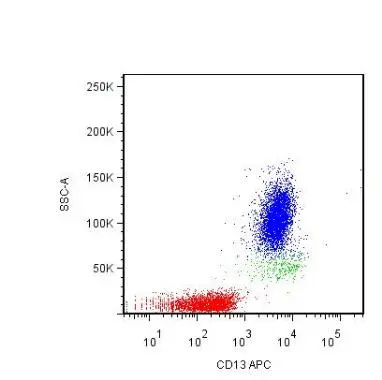CD13 antibody [WM15] (PerCP)
GTX27417-16
ApplicationsFlow Cytometry
Product group Antibodies
TargetANPEP
Overview
- SupplierGeneTex
- Product NameCD13 antibody [WM15] (PerCP)
- Delivery Days Customer9
- Application Supplier NoteFACS: 10 microl reagent / 100 microl of whole blood or 106 cells in a suspension. *Optimal dilutions/concentrations should be determined by the researcher.Not tested in other applications.
- ApplicationsFlow Cytometry
- CertificationResearch Use Only
- ClonalityMonoclonal
- Clone IDWM15
- ConjugatePerCP
- Gene ID290
- Target nameANPEP
- Target descriptionalanyl aminopeptidase, membrane
- Target synonymsAP-M, AP-N, APN, CD13, GP150, LAP1, P150, PEPN, hAPN, aminopeptidase N, alanyl (membrane) aminopeptidase, aminopeptidase M, membrane alanyl aminopeptidase, microsomal aminopeptidase, myeloid plasma membrane glycoprotein CD13
- HostMouse
- IsotypeIgG1
- Protein IDP15144
- Protein NameAminopeptidase N
- Scientific DescriptionAminopeptidase N is located in the small-intestinal and renal microvillar membrane, and also in other plasma membranes. In the small intestine aminopeptidase N plays a role in the final digestion of peptides generated from hydrolysis of proteins by gastric and pancreatic proteases. Its function in proximal tubular epithelial cells and other cell types is less clear. The large extracellular carboxyterminal domain contains a pentapeptide consensus sequence characteristic of members of the zinc-binding metalloproteinase superfamily. Sequence comparisons with known enzymes of this class showed that CD13 and aminopeptidase N are identical. The latter enzyme was thought to be involved in the metabolism of regulatory peptides by diverse cell types, including small intestinal and renal tubular epithelial cells, macrophages, granulocytes, and synaptic membranes from the CNS. Human aminopeptidase N is a receptor for one strain of human coronavirus that is an important cause of upper respiratory tract infections. Defects in this gene appear to be a cause of various types of leukemia or lymphoma. [provided by RefSeq, Jul 2008]
- Storage Instruction2°C to 8°C
- UNSPSC12352203
References
- Comparison of surface markers between human and rabbit mesenchymal stem cells. Lee TC et al., 2014, PLoS OneRead more


![FACS analysis of human peripheral blood leukocytes using GTX27417-02 CD13 antibody [WM15] (Biotin).](https://www.genetex.com/upload/website/prouct_img/normal/GTX27417-02/GTX27417-02_20191028_FACS_1_w_23060722_224.webp)
![FACS analysis of human peripheral blood leukocytes using GTX27417-08 CD13 antibody [WM15] (PE).](https://www.genetex.com/upload/website/prouct_img/normal/GTX27417-08/GTX27417-08_20191028_FACS_1_w_23060722_946.webp)

![IHC-P analysis of human liver tissue using GTX01910 CD13 antibody [38C12]. Note staining of the bile canaliculi.](https://www.genetex.com/upload/website/prouct_img/normal/GTX01910/GTX01910_20200811_IHC-P_12_w_23053121_581.webp)